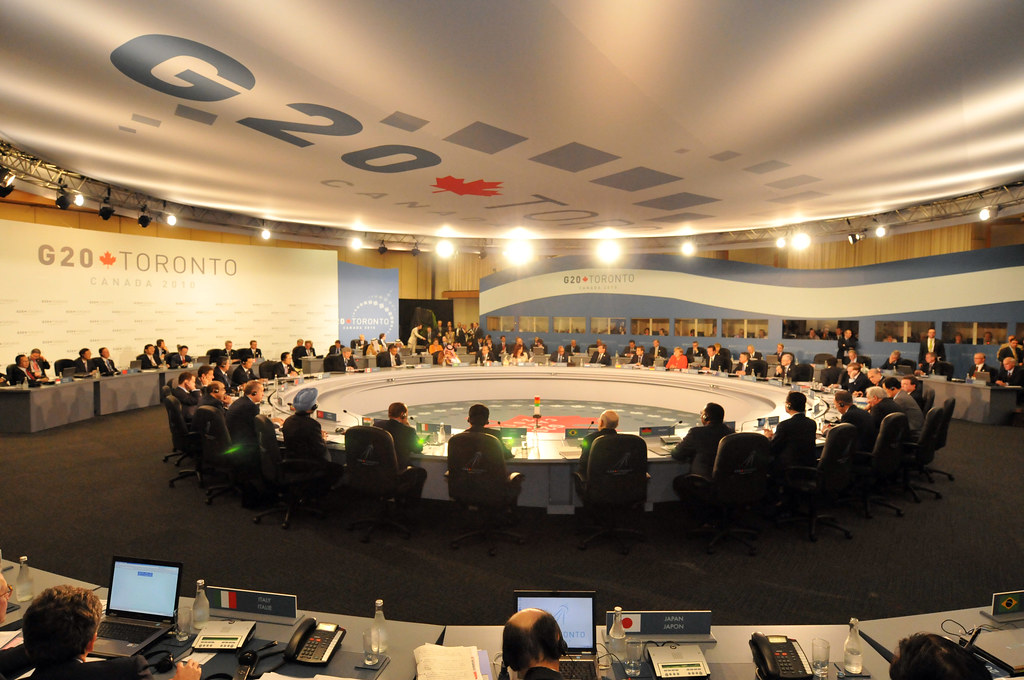Reports of progress last weekend notwithstanding, the so-called currency wars—the reality and threat of competitive devaluations—are likely to continue to dominate the news about the upcoming Seoul G-20 Summit. But while exchange rates matter a lot for developing countries (see recent posts by Liliana Rojas-Suarez and Arvind Subramanian), the summit will also address other issues important to the billion-plus people in low-income countries not represented by the G-20. Two involve pre-summit conferences I recently attended in South Korea; the third involves G-20 pledges of new anticorruption efforts.
More coverage of the G-20
Event: What to Watch for at the Seoul G-20 Summit, Nov. 2
As I
previously reported, Korean officials have made the most of the opening provided by the Toronto G-20 Summit decision to establish a working group on development. As co-chairs with South Africa, the Koreans consulted widely, including with nonmembers of the G-20, and crafted a development framework that reflects current thinking about development policy and draws upon Korea’s own experience achieving rich-country status.The framework is articulated in a
background paper by Alan Winters, Wonhyuk Lim, and two co-authors that was released at the
G-20 High Level Development Conference in Seoul.
Much of the paper will be familiar to anybody who has tracked the development policy debate, including the conclusion of the Spence Commission on Growth and Development that “there are no recipes, just ingredients” and the noncontroversial view that “growth strategies have to be developed and owned by LIC [low-income country] governments and societies and they need to be tailored to individual country needs.”Perhaps more interesting, especially to developing countries seeking to learn from Korea’s success, is the paper’s Annex 2, where Lim applies the framework in the main paper to examine Korea’s own experience. While stopping short of the radioactive term “
industrial policy,” Lim will seem to laissez-faire purists to come dangerously close in the following passage about Korea:
To promote development, the government and the private sector made joint efforts to address innovation and coordination externalities. They developed “a big-push partnership” in which the government shared the investment risks of the private sector and provided support largely based on performance in competitive global markets. The reinforcement of successful experiments through the feedback mechanism of performance based rewards led to dramatic changes over time.
As a longtime Korea watcher and former foreign correspondent resident in Seoul, I find this to be an accurate description of how the Korean government has pursued growth. It clearly involves much more than just providing a level playing field and open markets. Taken together with a strong push for exports and heavy investment in infrastructure that has also characterized the Korean and other East Asian success stories, the framework was seen by some conference participants (see Ben Philipps of Save the Children) as the articulation of a new “Seoul Consensus,” to supplant the much criticized (and oft misunderstood) Washington Consensus, which places greater faith in open markets and less emphasis on the need for a capable and active state (see
Birdsall et al: Washington Consensus: Assessing a Damaged Brand). Something significant, if subtle, is going on here: we are witnessing the emergence of a new conventional wisdom about development that more fully takes into account the East Asian experience.The framework set forth in the paper and other documents has been distilled by Korean officials, through consultations with development experts and governments around the world, into six broad principles (things like “focus on economic growth” and “complement existing efforts” of the UN, World Bank, and others) and nine multiyear action plans. The entire package was discussed and reviewed by the
G-20 sherpas who met in Seoul this month, and is scheduled to be endorsed by the leaders at the Summit next month.The rubber meets the road in the action plans, which cover areas such as infrastructure, private investment and job creation, human resource development (looking beyond enrollments to skill-related indicators), trade, food security, and growth with resilience. (This last item, and indeed the existence of the G20 development agenda, is in line with a
speech Nancy Birdsall gave on the eve of the third G20 Summit in Pittsburgh, in which she urged G20 leaders, still focused then on the 2008/09 financial meltdown, to address development issues and to begin to prepare for “the next global crisis.”Whether the action plans cover the right areas, and include appropriate deliverables, will appropriately be the subject of considerable debate in the development community. Perhaps more important, however, is that they exist at all, that the G-20, as the planet’s preeminent economic steering group, is beginning to move beyond emergency responses to the 2008 financial crisis, the catalyst for its creation, to take up a development agenda with detailed, multiyear commitments.
The First G-20 Civil DialogueThe contrast between the High Level Development Conference and the
G-20 Civil Dialogue was striking. The first was held in the grand ballroom of a pricey downtown Seoul hotel. Participants included some of the world’s top development economists, senior officials from the development establishment (the World Bank, DfID, the World Food Program, the WTO, and the UNDP), and Chinese sherpa (and vice minister of foreign affairs) Cui Tiankai. There were six sessions, lots of (often bad) slides, and little exchange with the audience, since nearly all sessions ran overtime. Few of the presenters were women, none were African.The Civil Dialogue was held in a modest hotel in Inchon’s Tomorrow City, a futuristic enclave far from Seoul whose gleaming, mostly unoccupied towers are surrounded by raw mudflats. The meeting room was a low-ceilinged affair where participants were packed knee-to-knee. The 100 attendees were about equally divided by region and gender, and there was A LOT of dialogue. Participants, many of whom head service delivery organizations, often lacked high-level academic qualifications but had plenty of first-hand experience working with poor people. They tended to be savvy about the policy debates and comfortable with jargon, including such seemingly arcane issues as IMF quota and Special Drawing Rights (SDRs). Views were left-leaning: austerity was mostly seen as unnecessary and antigrowth, aid was assumed to be useful, with the main problem being insufficient quantity.The two worlds came together on the second day of the Civil Dialogue, when participants were invited to meet the G-20 sherpas in a nearby convention center so new that gardeners were working on the landscaping as we entered the sprawling building. Fifteen members of the Civil Dialogue had been selected to ask questions drafted in five breakout sessions the day before. Speakers were seated at a vast curved table, with Korean sherpa Rhee Chang-yong and Anselmo Lee, chairman of the Global Call to Action Against Poverty (GCAP) Korea, side-by-side at the center, the sherpas seated to Rhee’s right, and the civil society representatives to Lee’s left. The Sherpa Times, which tracks G-20 sherpas comings and goings,
reported approvingly of the event as a rare instance of sherpa transparency. Nearly all the sherpas attended; with the notable and unfortunate exceptions of China’s Cui and the sherpa for Brazil.The civil society representatives proceeded to ask their prepared questions; the sherpas replied, ostensibly speaking only on behalf of their own governments but often seeming to reflect consensus positions that underpin the proclamations that will be released in Seoul next month. Several questions implicitly pushed for financial transactions tax, as part of a broader NGO agenda for innovative financing mechanisms to support the achievement of the Millennium Development Goals. Three pressed for G-20 action on climate. One speaker noted that the G-20 includes all of the top CO2 emitters, and asked, “What are G-20 leaders doing to build momentum for collective action to help communities to become climate resilient, to slow emissions growth, and to make plans to receive climate refugees?” (The EU sherpa gave the anticipated explanation that leaders are concerned about the issue, but that the appropriate venue for discussion is the United Nations, and in particular the upcoming COP16, to be held in Cancun in December.) The most revealing answer came in response to a question about anticorruption efforts (more about that below).But the lasting legacy of the meeting was not so much in the content as in that it happened at all. The G-20, seeking to assert its legitimacy, has established a precedent for pre-summit dialogue with representatives of civil society who are prepared to ask difficult questions. Whether this will make a difference remains to be seen. No doubt a planned meeting between the leaders and international business executives will have more clout!). Still, the meeting set a precedent that seems likely to become a regular feature of future G-20 meetings and is one of the few ways the G-20 can be at least questioned, if not held accountable, for its decisions.
G-20 Anticorruption EffortsIn addition to creating the development working group, the Toronto G-20 Summit also established a second working group, led by Indonesia and France, “to make comprehensive recommendations on how the G-20 can take practical steps to combat corruption.” Though developing countries certainly have no monopoly on corruption, the issue has an important development dimension, since corruption in poor countries is often a major impediment to poverty-reducing growth. Of course, rich countries and big emerging market countries are often complicit, because their firms pay the biggest bribes, and the ill-gotten gains are then often hidden in financial institutions in rich countries.Until now, little has been reported about the progress of this group, so the briefing offered by Mahendra Siregar, the Indonesian sherpa, in response to the question was news. The working group, he said, has met several times by phone and once face-to-face in Indonesia. The resulting plan has been discussed by the G-20 sherpas and, following their approval, will be submitted to the leaders at the summit.Siregar said that the anticorruption action plan includes nine key areas and a section on the role of the private sector:
- Accession and ratification of the United Nations Convention against Corruption (UNCAC) and its peer review mechanism
- Bribery criminalization and more active engagement with OECD working group on bribery
- Combating money laundering, e.g., through the Financial Action Task Force (FATF)
- A cooperating framework for denial of safe havens to corrupt officials
- Cooperation on the recovery of stolen assets
- Protection of whistle blowers
- Enforcement authorities
- Prevention of public sector corruption
- Public private partnerships—engaging the private sector against corruption
Obviously a lot will depend upon the details.
Ted Moran a CGD visiting fellow who has written extensively on rich-world efforts to stop corporate bribe-payers in developing countries, told me that there has been recent progress on Nos. 4 and 5, and that it would “be nice to have the G-20 signal support.” What seems to be notably absent from the list, he says, is a commitment to back the
Extractive Industries Transparency Initiative (EITI), and to extend its remit so that members report payments on a company-by-company basis (or even, as in the so-called EITI ++ agenda of the World Bank, by procurement contracts). Ted writes:
There is evidence to show that—contrary to what some multinational corporations claim—this requirement does not damage their competitive position or reveal confidential business information in any detrimental fashion. What such a requirement would do is force non-OECD investors—Chinese, Russians, Indians, etc.—to more closely conform to what the more exemplary OECD investors do now. It would be useful to get G-20 (i.e. broader than OECD) endorsement for this attempt to level the playing field for investors.
The issue remains in play and while some in official circles were dismissive when it was first proposed as a means of preventing future financial crises, it seems that it may yield real benefits, especially for people in developing countries. Siregar said that the working group will meet again in early 2011, and that there will be further consultations with representative of the private sector, civil society, and specific industries. He added that there would be “clear plans for implementation” next year and that the issue would be pursued by France, which has championed the initiative and will host the next G-20 in 2011.
CGD blog posts reflect the views of the authors, drawing on prior research and experience in their areas of expertise.
CGD is a nonpartisan, independent organization and does not take institutional positions.







